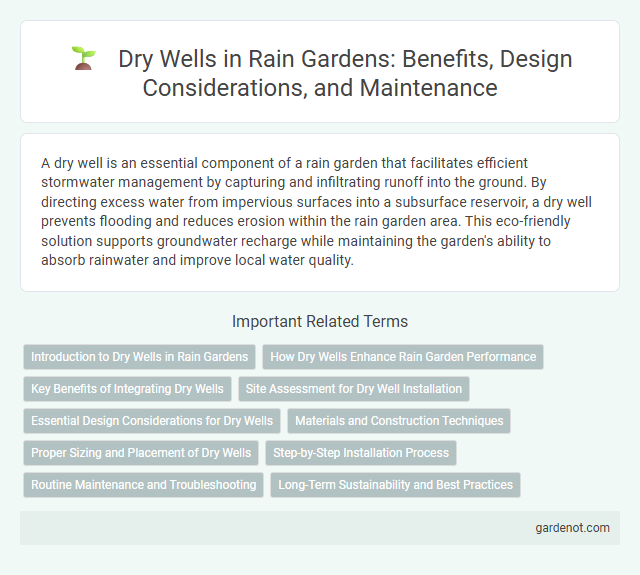A dry well is an essential component of a rain garden that facilitates efficient stormwater management by capturing and infiltrating runoff into the ground. By directing excess water from impervious surfaces into a subsurface reservoir, a dry well prevents flooding and reduces erosion within the rain garden area. This eco-friendly solution supports groundwater recharge while maintaining the garden's ability to absorb rainwater and improve local water quality.
Introduction to Dry Wells in Rain Gardens
Dry wells in rain gardens serve as underground structures designed to collect and infiltrate stormwater, preventing surface runoff and reducing erosion. These systems typically consist of a gravel-filled pit or chamber that temporarily stores water, allowing it to slowly percolate into the surrounding soil. Integrating dry wells enhances rain garden efficiency by managing excess water during heavy rainfall, promoting groundwater recharge, and mitigating urban flooding.
How Dry Wells Enhance Rain Garden Performance
Dry wells enhance rain garden performance by efficiently managing stormwater runoff, allowing excess water to infiltrate deeply into the ground and prevent surface flooding. These underground structures capture and store runoff from impermeable surfaces, promoting groundwater recharge while reducing erosion and pollutant transport. Integrating dry wells with rain gardens optimizes water absorption capacity, ensuring better control of urban water flow and improving overall landscape sustainability.
Key Benefits of Integrating Dry Wells
Integrating dry wells in rain gardens enhances stormwater management by efficiently capturing and infiltrating runoff, reducing surface flooding and erosion. These underground structures promote groundwater recharge and improve water quality by filtering pollutants before they enter the soil. Their ability to handle large volumes of water makes them ideal for urban landscapes aiming for sustainable drainage solutions.
Site Assessment for Dry Well Installation
Site assessment for dry well installation involves analyzing soil permeability, depth to groundwater, and drainage patterns to ensure effective stormwater management. Conducting percolation tests and evaluating site topography helps determine the optimal location and dimensions for the dry well to prevent surface water pooling and groundwater contamination. Accurate assessment maximizes infiltration efficiency and prolongs the dry well's functionality in rain garden systems.
Essential Design Considerations for Dry Wells
Dry wells require proper sizing based on soil infiltration rates and the volume of runoff to ensure efficient water absorption without causing surface flooding. Location selection must avoid areas with high water tables or bedrock to prevent groundwater contamination and structural issues. Incorporating a pre-treatment layer with gravel and a geotextile filter fabric is crucial to trap sediments and prolong the dry well's lifespan.
Materials and Construction Techniques
Dry wells are commonly constructed using materials like precast concrete, corrugated plastic, or galvanized steel to create durable underground chambers that facilitate stormwater infiltration. Construction techniques involve excavating a deep pit, lining it with geotextile fabric to prevent soil infiltration, and filling the chamber with clean, coarse gravel or aggregate to promote efficient water dispersion. Proper installation ensures effective drainage, helps manage runoff from rain gardens, and reduces surface flooding by directing excess water into the groundwater system.
Proper Sizing and Placement of Dry Wells
Proper sizing and placement of dry wells are crucial for effective stormwater management in rain gardens, ensuring efficient infiltration and preventing waterlogging. Dry wells must be sized based on the volume of runoff and soil permeability, typically designed to handle peak flow from impervious surfaces. Strategic placement downhill and away from building foundations enhances groundwater recharge while mitigating flood risks.
Step-by-Step Installation Process
A dry well installation begins by selecting a location with adequate drainage and digging a hole approximately three times the size of the dry well unit. Next, a gravel layer is placed at the bottom to facilitate water infiltration, followed by positioning the dry well and connecting the downspout or drainage pipe to direct runoff into the system. Finally, the dry well is covered with filter fabric and backfilled with soil, ensuring proper compaction and surface restoration to promote efficient rainwater absorption and prevent erosion.
Routine Maintenance and Troubleshooting
Dry wells in rain gardens require regular inspection to ensure efficient water infiltration and prevent clogging from sediment and debris. Routine maintenance involves removing accumulated organic matter and checking for any structural damage or signs of soil erosion around the well. Addressing issues like slow drainage or water pooling promptly helps maintain optimal performance and extends the lifespan of the dry well system.
Long-Term Sustainability and Best Practices
Dry wells enhance long-term sustainability in rain gardens by effectively managing stormwater infiltration and reducing surface runoff. Best practices include proper sizing based on soil permeability, regular inspection to prevent clogging, and use of durable materials like perforated plastic or concrete rings. Integrating dry wells with native vegetation promotes groundwater recharge and minimizes erosion while supporting ecosystem health.
Dry well Infographic

 gardenot.com
gardenot.com